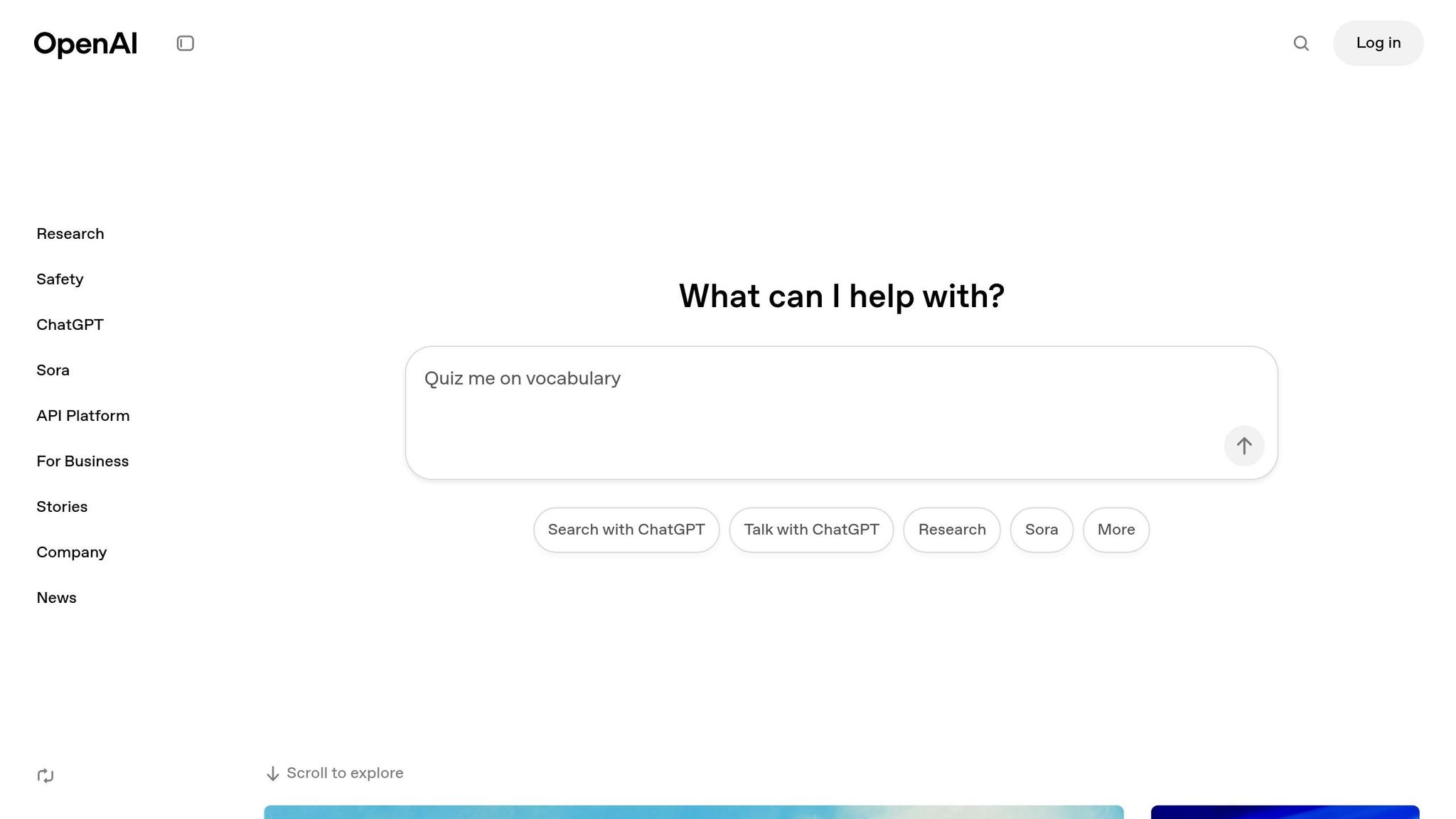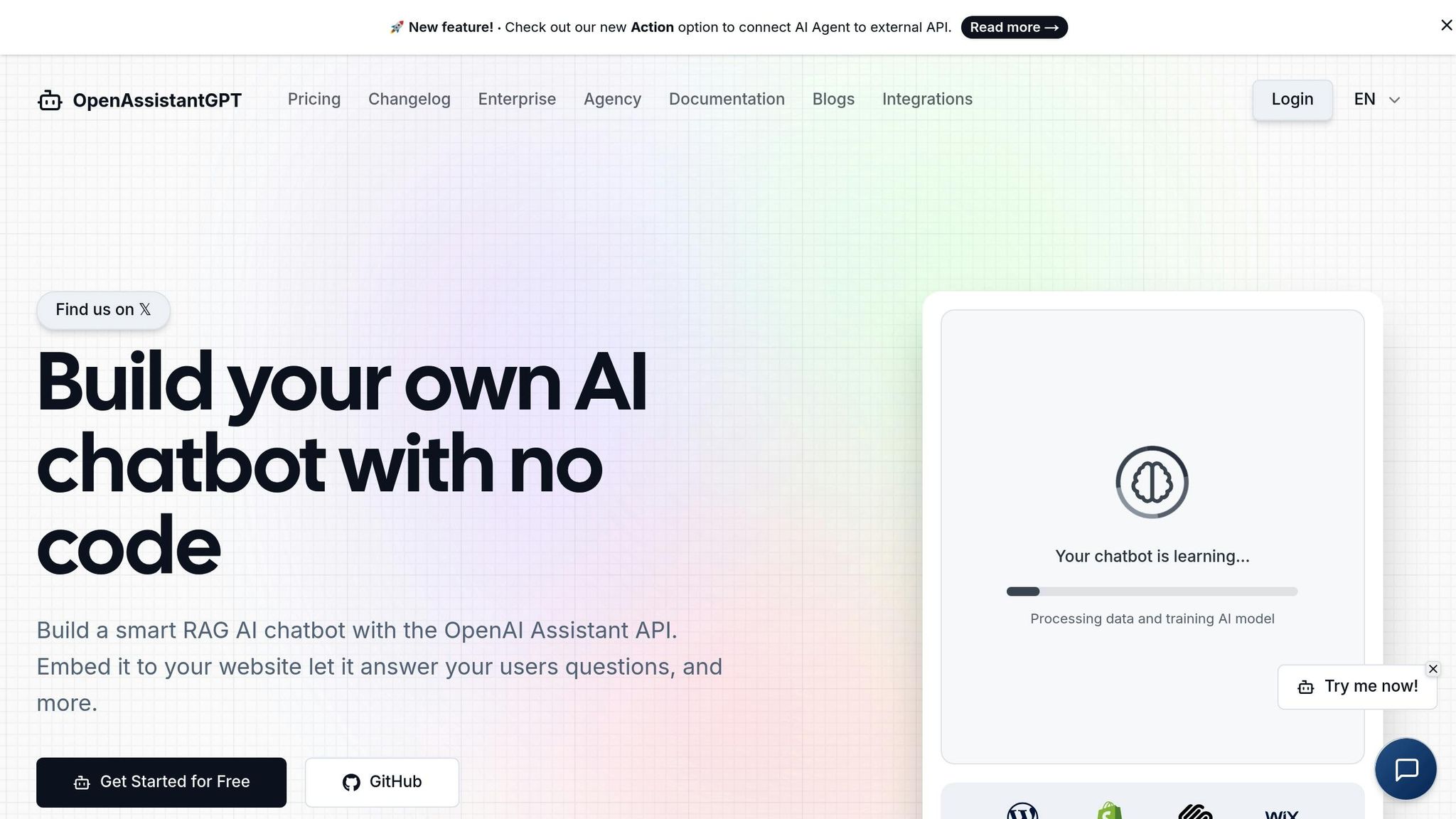Build AI Chatbot using OpenAI Response API

Build AI Chatbot using OpenAI Response API
Want to build an AI chatbot quickly and easily? The OpenAI Response API and no-code platforms like OpenAssistantGPT make it possible. Here's what you need to know:
- What You Can Do: Create chatbots that answer questions, search files, and integrate with APIs. Use tools like web crawling and multi-agent workflows for advanced capabilities.
- Key Features: OpenAI Response API combines Chat Completions with tools for web and file search. OpenAssistantGPT simplifies development with no-code options.
- Costs: Web search starts at $30/1,000 queries, file search at $2.50/1,000 queries, and storage at $0.10/GB/day (first GB free).
- Plans: OpenAssistantGPT offers free and paid plans starting at $18/month for more chatbots and features.
- How to Start: Set up an OpenAI account, generate an API key, and install the SDK. Use OpenAssistantGPT for a no-code approach.
Quick Comparison Table:
| Feature | OpenAI Response API | OpenAssistantGPT |
|---|---|---|
| Setup Complexity | Requires coding and SDK setup | No-code platform, easy to use |
| Key Features | Web/file search, API integration | Web crawling, lead capture, SSO |
| Cost | Pay-per-use pricing | Monthly subscription plans |
| Best For | Developers | Non-developers and small teams |
Start by defining your chatbot's purpose, building chat flows, and integrating it into your website. Test thoroughly and optimize for accuracy, speed, and user satisfaction.
Creating A Custom OpenAI Chatbot With No-Code Using Bubble

Setup Requirements and Tools
Start building your AI chatbot by setting up the necessary accounts and tools.
OpenAI Account Setup
To use the OpenAI Response API for chatbot development, follow these steps to set up your OpenAI account:
-
Account Creation
Go to OpenAI's website and create a developer account. Fill in your details and confirm your email address. -
API Key Generation
After setting up your account, head to the API section in your dashboard to generate an API key. This key is essential for authentication and should be stored securely in theOPENAI_API_KEYenvironment variable. -
Understand Usage Costs
Be aware of the pricing for different features:- Web search: $30 per 1,000 queries (GPT-4o search)
- File search: $2.50 per 1,000 queries
- Storage: $0.10/GB/day (first GB is free)
- Compute usage: $3 per 1M input tokens, $12 per 1M output tokens
OpenAssistantGPT Platform Overview

OpenAssistantGPT is a no-code platform designed to simplify chatbot development. It offers several subscription plans:
| Plan | Monthly Cost | Features |
|---|---|---|
| Free | $0 | 1 chatbot, 500 messages/month, Basic tools |
| Basic | $18 | 9 chatbots, Unlimited messages, Lead collection |
| Pro | $54 | 27 chatbots, File attachments, Custom domains |
| Enterprise | Custom | Unlimited resources, SAML/SSO, SLA guarantee |
Once your account is configured, you can move on to integrating the SDK for development.
SDK Integration Steps
To integrate the SDK programmatically, follow these steps:
-
Install the SDK
Add the OpenAI SDK to your project using a package manager:npm install @ai-sdk/openai -
Configure the Provider
Set up an OpenAI provider instance in your code:const provider = new OpenAIProvider({ apiKey: process.env.OPENAI_API_KEY, organization: 'your-org-id' }); -
Set Up Implementation
The SDK supports multiple models, including language, chat, response, completion, embedding, and image models. Choose the model that matches your needs and implement it accordingly.
"The Responses API represents the future direction for building agents on OpenAI." - OpenAI
Chatbot Design and Features
Setting Chatbot Purpose and Users
Start by clearly defining what your chatbot should do and who it will serve. OpenAssistantGPT offers an easy-to-use interface to configure your chatbot’s main tasks.
Here’s how to outline its purpose and audience:
-
Core Functions
- Respond to customer inquiries
- Share product details
- Qualify leads
- Create support tickets
-
User Segments
- Identify primary audience demographics
- Assess their technical knowledge
- Understand common challenges they face
- Determine their preferred communication style
By having a clear purpose and knowing your users, you can craft chat flows that feel natural and conversational.
Building Chat Flows
Your chatbot’s conversations should reflect your brand while feeling natural. OpenAssistantGPT makes it simple to design these flows using the Agents SDK, which helps manage multi-agent workflows effortlessly.
A good chat flow typically includes:
- A friendly opening message
- Categorization of the user’s intent
- Contextual responses based on user input
- Follow-up questions to clarify or deepen the conversation
- A clear, satisfying conclusion, often with a feedback request
Once you’ve built the basics, you can layer in advanced features to make your chatbot even more effective.
Advanced Feature Setup
Enhance your chatbot’s capabilities by using advanced APIs and SDK tools to create smoother, more personalized interactions.
Consider adding these features:
- Web crawling for gathering and processing online data
- File processing with options for metadata filtering and reranking
- Multi-agent workflows using the Agents SDK for seamless coordination
The file search tool is especially powerful, offering precise metadata filtering and custom reranking to deliver highly accurate responses.
"With built-in query optimization and reranking, they are able to set up a powerful RAG pipeline without extra tuning or configuration."
sbb-itb-7a6b5a0
Development and Launch Steps
API Connection Setup
OpenAssistantGPT makes it easy to set up a secure API connection through its user-friendly, no-code interface. You can configure authentication in the platform dashboard, where token management and API rate limiting are handled automatically. The integration with OpenAI's Responses API combines the simplicity of Chat Completions with advanced tools, offering features like:
- Safety checks to validate inputs and outputs
- Automated query optimization and reranking
- Observability tools for tracking and inspecting workflows
Once your connection is set up, it's time to thoroughly test your chatbot.
Testing and Error Fixes
OpenAssistantGPT provides powerful testing tools to ensure your chatbot performs as expected. Focus on these key areas during testing:
- Response Accuracy: Use the observability tools to trace workflows and pinpoint inconsistencies in logic or responses.
- Performance Monitoring: Check response times and token usage, leveraging the platform's optimization features.
- Error Resolution: Built-in debugging tools will help address common issues such as:
- Input validation errors
- Problems with response formatting
- API connection timeouts
- Token limit exceptions
Website Integration Guide
After completing API setup and testing, you can integrate your chatbot into your website. OpenAssistantGPT offers several integration options:
- Embed Code: A JavaScript snippet for quick and easy implementation.
- API Endpoints: For more customized integrations.
- Security Controls: SAML/SSO authentication for private or restricted chatbots.
Here’s a quick overview of integration options:
| Integration Type | Setup Time | Technical Requirements |
|---|---|---|
| Basic Embed | 5–10 minutes | Basic HTML knowledge |
| Custom API | 1–2 hours | Developer expertise |
| SSO Setup | 2–4 hours | IT admin access |
The platform's SDK supports all OpenAI models and works seamlessly with standard Chat Completions API endpoints, ensuring flexibility for updates or customizations.
Performance Improvements
With a solid foundation in setup and design, performance enhancements ensure your chatbot operates with accuracy and efficiency.
Response Quality Enhancement
OpenAssistantGPT uses the OpenAI Responses API for query optimization and automated reranking, delivering accurate, context-aware responses. For instance, its file search feature improves response precision by referencing specific knowledge bases.
Performance is further supported by observability tools that track key metrics:
| Metric | Purpose | Impact |
|---|---|---|
| Response Accuracy | Measures answer precision | Reduces user frustration |
| Token Usage | Tracks API consumption | Helps manage operational costs |
| Response Time | Monitors speed of replies | Enhances user experience |
| Error Rates | Flags potential issues | Boosts reliability |
User Data Collection Methods
OpenAssistantGPT includes tools for collecting user data while prioritizing privacy. Its lead collection feature tracks user inquiries and engagement patterns, helping businesses analyze conversation flows, identify frequent questions, assess response effectiveness, and gauge user satisfaction. These insights work alongside robust security measures to ensure both performance and safety.
Security Measures
Security plays a critical role in deploying AI chatbots. OpenAssistantGPT includes several layers of protection:
-
Authentication Controls
SAML/SSO integration ensures only authorized users can access private chatbots. This supports compliance with security policies and provides detailed activity tracking. -
Data Protection
Multiple safeguards are in place, including:- Encrypted data transmission
- Secure file storage ($0.10/GB/day, with the first GB free)
- Role-based access controls
- Automated security checks
-
API Security
API connections are protected through:- Token management
- Rate limiting
- Input validation
- Output sanitization
"Box was able to quickly create agents that leverage web search and the Agents SDK to enable enterprises to search, query, and extract insights from unstructured data stored within Box and public internet sources. This approach allows customers to not only access the latest information, but also search their internal, proprietary data in a safe and secure way that obeys their internal permissions and security policies."
Conclusion
After reviewing the setup, design, and performance improvements, here's a quick rundown of the main benefits of using the OpenAI Response API with OpenAssistantGPT.
Key Takeaways
Building AI chatbots with the OpenAI Response API offers a straightforward development process paired with advanced functionality. Its features include:
- Easy Integration: Combines chat features with tools like web search and file analysis, making deployment faster and simpler.
- Scalable and Budget-Friendly: Transparent pricing ensures predictable costs for web search and storage as your needs grow.
- Enterprise Features: Security controls and SSO authentication make it a solid choice for organizational use.
This platform has been successfully applied across multiple industries, proving its ability to address a wide range of business challenges.
Steps to Get Started
Here’s how to kick off your chatbot project:
-
Setup and Development
- Sign up for an OpenAI account.
- Define the chatbot’s goals and objectives.
- Build core features and integrate tools like web search or file analysis.
- Set up security measures.
-
Testing and Optimization
- Test responses for accuracy and relevance.
- Track performance metrics.
- Refine settings based on user feedback.
Once your chatbot is built, use the platform’s built-in tools to monitor performance and ensure smooth, high-quality interactions over time. Ongoing optimization is key to long-term success.